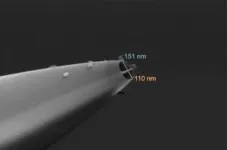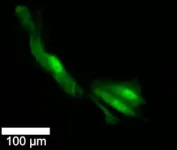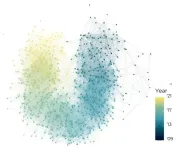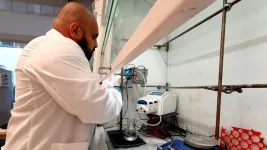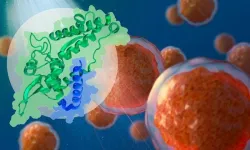(Press-News.org) Greg Rouse, a marine biologist at UC San Diego’s Scripps Institution of Oceanography, and other researchers have discovered a new species of deep-sea worm living near a methane seep some 50 kilometers (30 miles) off the Pacific coast of Costa Rica. Rouse, curator of the Scripps Benthic Invertebrate Collection, co-authored a study describing the new species in the journal PLOS ONE that was published on March 6.
The worm, named Pectinereis strickrotti, has an elongated body that is flanked by a row of feathery, gill-tipped appendages called parapodia on either side, and Rouse said its sinuous swimming reminded him of a snake. The species was named after Woods Hole Oceanographic Institution’s Bruce Strickrott, lead pilot for the famed deep-sea submersible Alvin, who Rouse said was instrumental in the effort to locate and collect the creature. The research was supported by the National Science Foundation.
Rouse and his colleagues have encountered roughly 450 species at the Costa Rican methane seeps since 2009, with this latest discovery bringing the number of those species that were new to science to 48. These impressive stats underscore how much more there is left to learn about these ecosystems as well as their biological importance, said Rouse.
Methane seeps are parts of the seafloor where the powerful greenhouse gas methane escapes from rocks or sediment on the seafloor in the form of bubbles. Unlike deep-sea hydrothermal vents, methane seeps are typically not hotter than the surrounding water. But like hydrothermal vents, methane seep ecosystems are fueled by chemical energy rather than sunlight. This is because some microbes have evolved the ability to consume methane. The microbes that can make methane into food create the base of a food web that at the Costa Rican seeps is dominated by mussels, crabs, and soft-bodied polychaete worms like this new species, said Rouse.
Strickrott and Rouse first encountered the new species in 2009 at a depth of around 1,000 meters (3,280 feet) during a dive in the Alvin human-occupied submersible, which is operated by the Woods Hole Oceanographic Institution and owned by the U.S. Navy.
“We saw two worms near each other about a sub’s length away swimming just off the bottom,” said Strickrott. “We couldn’t see them well and tried to creep in for a closer look, but it’s hard to creep in a submarine and we spooked them.”
Finally, in 2018 the team was able to return to Costa Rica’s methane seeps with Alvin. On a dive to the same spot the worm was first sighted, known as Mound 12, Strickrott was astounded to encounter six or more individuals of the unidentified species they first saw there nearly a decade earlier. For some reason, the worms were much less skittish than they were in 2009 and, using a five-chambered vacuum canister device on Alvin that Strickrott calls the “slurp gun,” they carefully collected several specimens as well as images and video – enough to formally describe what proved to be a new species.
“The way this thing moved was so graceful, I thought it looked like a living magic carpet,” said Strickrott. “I’m honored that Greg [Rouse] saw fit to name this species after me, it means a lot.”
Pectinereis strickrotti is a 10-centimeter-long (4-inch) member of the ragworm family (Nereididae). Ragworms are a group of around 500 species of segmented, mostly-marine worms that look a bit like a cross between a centipede and an earthworm. They have elongated bodies with rows of bristled parapodia on their sides and a hidden set of pincer-shaped jaws that can be extruded for feeding. Many species of ragworm also have two distinct life stages: atoke and epitoke. In these species, the worm spends most of its life on the seafloor, often in a burrow, as a sexually immature atoke, but in their life’s final act they transform into sexually mature epitokes that swim up off the bottom into the water column to find mates and spawn.
The team was able to collect three male Pectinereis strickrotti epitokes and part of one female. Following their successful collection, the team used the specimens to conduct anatomical analysis and to study the worm’s DNA to establish its evolutionary relationships within the ragworm family. The specimens now reside in Scripps’ Benthic Invertebrate Collection and the Museo de Zoología at the Universidad de Costa Rica.
Compared to most ragworms, Pectinereis strickrotti is unusual in several ways. First, it lives in the deep sea, while the majority of its evolutionary kin inhabit shallower waters. Second, its parapodia are covered in gills, while most ragworms absorb oxygen through their parapodia without the aid of true gills. The males had large spines at the end of their tails, which Rouse said might have something to do with reproduction but would require further study. Finally, owing to the total darkness at 1,000 meters (3,280 feet) under the sea, the new species is blind. Rouse said the worms probably have keen senses of smell and touch to help them navigate their inky world.
Pectinereis strickrotti has robust, even fearsome-looking jaws, but Rouse said their diet is still unknown and that the species could just as easily be feeding on bacteria as larger fare like other worms. Though its coloration would be a moot point in life, given its pitch black habitat, Rouse said the worm appeared rosy under Alvin’s lights, and that this was probably due to the color of its blood.
“We’ve spent years trying to name and describe the biodiversity of the deep sea,” said Rouse. “At this point we have found more new species than we have time to name and describe. It just shows how much undiscovered biodiversity is out there. We need to keep exploring the deep sea and to protect it.”
Rouse and other Scripps researchers will be heading back out to sea later this year in hopes of making even more deep-sea discoveries at methane seeps off the coasts of Alaska and Chile.
In addition to Rouse, Sonja Huč, Avery Hiley, and Ekin Tilic of Scripps contributed to the study. Tulio Villalobos-Guerrero of the Centro de Investigación Científica y de Educación Superior de Ensenada is the study’s first author and conducted the primary anatomical analysis.
The Scripps Oceanographic Collections are comprised of millions of biological and geological marine specimens, providing a record of the state of the ocean environment over the past century that serves as a resource to researchers and students all over the world. To support the collections, members of the public can join the membership group Friends of the Collections or consider naming a new species to support the research and preservation required to establish the species in the scientific record permanently.
END
New deep-sea worm discovered at methane seep off Costa Rica
The creature raises the number of new species found by scientists studying these seemingly inhospitable ecosystems to 48
2024-03-06
ELSE PRESS RELEASES FROM THIS DATE:
Nanosurgical tool could be key to cancer breakthrough
2024-03-06
The high-tech double-barrel nanopipette, developed by University of Leeds scientists, and applied to the global medical challenge of cancer, has - for the first time - enabled researchers to see how individual living cancer cells react to treatment and change over time – providing vital understanding that could help doctors develop more effective cancer medication.
The tool has two nanoscopic needles, meaning it can simultaneously inject and extract a sample from the same cell, expanding its potential uses. And the platform’s high level of semi-automation has sped ...
Genetic mutation in a quarter of all Labradors hard-wires them for obesity
2024-03-06
New research finds around a quarter of Labrador retriever dogs face a double-whammy of feeling hungry all the time and burning fewer calories due to a genetic mutation.
This obesity-driving combination means that dog owners must be particularly strict with feeding and exercising their Labradors to keep them slim.
The mutation is in a gene called POMC, which plays a critical role in hunger and energy use.
Around 25% of Labradors and 66% of flatcoated retriever dogs have the POMC mutation, which researchers previously showed causes increased interest in food ...
MIT scientists use a new type of nanoparticle to make vaccines more powerful
2024-03-06
CAMBRIDGE, MA -- Many vaccines, including vaccines for hepatitis B and whooping cough, consist of fragments of viral or bacterial proteins. These vaccines often include other molecules called adjuvants, which help to boost the immune system’s response to the protein.
Most of these adjuvants consist of aluminum salts or other molecules that provoke a nonspecific immune response. A team of MIT researchers has now shown that a type of nanoparticle called a metal organic framework (MOF) can also provoke a strong immune response, by activating the innate immune system — the body’s first line of defense against ...
A noninvasive treatment for “chemo brain”
2024-03-06
CAMBRIDGE, MA -- Patients undergoing chemotherapy often experience cognitive effects such as memory impairment and difficulty concentrating — a condition commonly known as “chemo brain.”
MIT researchers have now shown that a noninvasive treatment that stimulates gamma frequency brain waves may hold promise for treating chemo brain. In a study of mice, they found that daily exposure to light and sound with a frequency of 40 hertz protected brain cells from chemotherapy-induced damage. The treatment also helped to prevent memory loss and impairment of other ...
Film festivals are becoming more diverse in several ways, new study reports
2024-03-06
A group of Tallinn University researchers has published an innovative study that sheds light on the intricate dynamics of the global film festival circuit, revealing insights into diversity and public value creation within the industry. The research demonstrates that festival programming has become more thematically diverse, and the inclusion of films by women creatives has increased between 2012–2021.
The study “Quantifying the global film festival circuit: Networks, diversity, and public value creation,” published open access in the PLOS ONE journal, provides a comprehensive analysis of over 600 film festivals worldwide, spanning a period ...
New hydrogen producing method is simpler and safer
2024-03-06
Researchers in Sweden unveiled a new concept for producing hydrogen energy more efficiently, splitting water into oxygen and hydrogen without the dangerous risk of mixing the two gases.
Developed at KTH Royal Institute of Technology in Stockholm, the new method decouples the standard electrolysis process for producing hydrogen gas, which splits water molecules by applying an electric current. In contrast with prevailing systems it produces the resulting oxygen and hydrogen gases separately rather than simultaneously in the same cell, where they need to be separated by membrane barriers
That separation eliminates the possibility of the gases mixing with the risk of explosions, says ...
Studying the relationship between cancer-promoting proteins
2024-03-06
By Simonne Griffith-Jones, Predoctoral Fellow, EMBL Grenoble
Researchers from the Bhogaraju Group at EMBL Grenoble have gained new insights into how a cancer-relevant family of proteins bind their targets. The results of the study, published in The EMBO Journal, could potentially help in the development of drugs against certain chemotherapy- and radiotherapy-resistant cancers.
The Melanoma Antigen Gene (MAGE) family consists of more than 40 proteins in humans, most of which are only present in the ...
UTA educating schoolchildren about solar eclipse
2024-03-06
The University of Texas at Arlington has received a grant from the National Science Foundation (NSF) to support educational activities related to the upcoming eclipse.
UTA faculty and graduate students are visiting elementary, middle and high schools in the DFW area in March to give talks to about 4,000 students explaining the natural phenomena occurring during the eclipse and the physics behind it. UTA will also provide special eclipse glasses for students to use to avoid eye damage.
The $50,000 grant will also provide for about 1,500 students to take field trips to the UTA Planetarium, one of the three largest in Texas, to learn ...
Espresso yourself: Wearable tech measures emotional responses to coffee
2024-03-06
Researchers in Italy have introduced a novel approach for assessing the quality of coffee. In a pioneering new study, they have demonstrated the feasibility of using wearable technology to measure the emotional responses of coffee experts during tastings.
Published in SCI’s Journal of the Science of Food and Agriculture, the study provides an innovative solution for reducing judgement biases that can result from traditional and more subjective methods of coffee quality assessment.
Coffee is one of the most popular and widely consumed beverages in the world, ...
What drives ‘drug-induced homicide’ prosecutions in North Carolina?
2024-03-06
A new study finds that prosecutors in North Carolina believe “drug-induced homicide” (DIH) laws are effective at both reducing drug overdoses in a community and curtailing the distribution of illicit drugs. These beliefs are worth noting because there is no evidence to support them, while there is evidence that DIH prosecutions make people in affected communities less likely to call 911 – and may actually increase the number of overdoses in a community.
DIH laws, also called “death by distribution” or “delivery resulting in death” laws, ...
LAST 30 PRESS RELEASES:
Normalizing blood sugar can halve heart attack risk
Lowering blood sugar cuts heart attack risk in people with prediabetes
Study links genetic variants to risk of blinding eye disease in premature infants
Non-opioid ‘pain sponge’ therapy halts cartilage degeneration and relieves chronic pain
AI can pick up cultural values by mimicking how kids learn
China’s ecological redlines offer fast track to 30 x 30 global conservation goal
Invisible indoor threats: emerging household contaminants and their growing risks to human health
Adding antibody treatment to chemo boosts outcomes for children with rare cancer
Germline pathogenic variants among women without a history of breast cancer
Tanning beds triple melanoma risk, potentially causing broad DNA damage
Unique bond identified as key to viral infection speed
Indoor tanning makes youthful skin much older on a genetic level
Mouse model sheds new light on the causes and potential solutions to human GI problems linked to muscular dystrophy
The Journal of Nuclear Medicine ahead-of-print tip sheet: December 12, 2025
Smarter tools for peering into the microscopic world
Applications open for funding to conduct research in the Kinsey Institute archives
Global measure underestimates the severity of food insecurity
Child survivors of critical illness are missing out on timely follow up care
Risk-based vs annual breast cancer screening / the WISDOM randomized clinical trial
University of Toronto launches Electric Vehicle Innovation Ontario to accelerate advanced EV technologies and build Canada’s innovation advantage
Early relapse predicts poor outcomes in aggressive blood cancer
American College of Lifestyle Medicine applauds two CMS models aligned with lifestyle medicine practice and reimbursement
Clinical trial finds cannabis use not a barrier to quitting nicotine vaping
Supplemental nutrition assistance program policies and food insecurity
Switching immune cells to “night mode” could limit damage after a heart attack, study suggests
URI-based Global RIghts Project report spotlights continued troubling trends in worldwide inhumane treatment
Neutrophils are less aggressive at night, explaining why nighttime heart attacks cause less damage than daytime events
Menopausal hormone therapy may not pose breast cancer risk for women with BRCA mutations
Mobile health tool may improve quality of life for adolescent and young adult breast cancer survivors
Acupuncture may help improve perceived breast cancer-related cognitive difficulties over usual care
[Press-News.org] New deep-sea worm discovered at methane seep off Costa RicaThe creature raises the number of new species found by scientists studying these seemingly inhospitable ecosystems to 48

